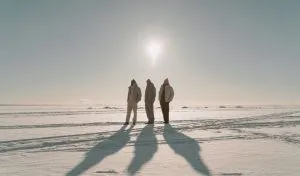Antarctica has no government and no native population, so you might think that it’s easy to visit. However, that’s not necessarily true. So, can you simply rock up to visit without permission, or is Antarctica off limits?
Antarctica is not off limits or guarded, as military activity is prohibited under the Antarctic Treaty. However, you still need permission to visit Antarctica from your own country or the country you will pass through (tour operators usually handle this on your behalf). Without permission, it’s unlikely that you’ll be allowed to board transport to the continent.
In the rest of this article, we’ll look in detail at the rules of visiting Antarctica and we’ll reveal a legal hack that could help you visit without permission (although it’s very unlikely to work).
Why is Antarctica Guarded?
Antarctica is not guarded by a military or off-limits, in fact, it’s the only continent where there is an effective international demilitarization agreement, called the Antarctic Treaty, which promotes peace and prohibits any military activity in the region.
Specifically, Article I of the treaty prohibits:
- Any measures of a military nature (including the establishment of military bases)
- Carrying out military maneuvers
- Any kind of weapons testing
However, the same article also goes on to say that the treaty does not prevent the use of military personnel or equipment for scientific research or for any other peaceful purposes1 (source: National Science Foundation).
Many countries use their military personnel and equipment to support scientific research.
For example, the US airforce provides airlift support between New Zealand and McMurdo Station (the largest research station in Antarctica) and the US Navy provides weather forecasting, air traffic control, base operations, systems maintenance, systems engineering, and information security services in Antarctica2 (source: United States Antarctic Program).
Who Can Visit Antarctica?
Antarctica is not owned by anyone and does not have its own government so you do not need a visa to visit (although you may need a passport to re-enter your own country afterward).
If you are visiting Antarctica by yourself, you can apply for permission through your national government (some links are provided at the end), however, if you are visiting as a tourist, your tour operator will usually apply on your behalf so no action is required.
Interested in a once-in-a-lifetime tour of Antarctica? Check out our article on the 7 best Antarctica Cruise Expeditions!
If you are not a citizen of one of the signatories of the treaty, but you are using a tour operator based in one of these countries, or you will be using a transport hub in one of these countries, then it’s likely that you will still need permission.
Can I Go To Antarctica?
Yes, you can go to Antarctica on an organized tour, this might be on an Antarctic cruise or you can fly there and stay at a campsite. However, you cannot go there on your own because the Antarctic treaty requires you to get permission from your home country or the country you will pass through.
Why do we protect Antarctica?
There are numerous reasons why Antarctica is protected:
- Environmental Importance: Antarctica is home to unique ecosystems and biodiversity, with species found nowhere else on the planet. It acts as a natural laboratory for studying the impacts of climate change and provides valuable data for understanding global environmental processes.
- Scientific Research: Antarctica serves as a hub for scientific exploration and discovery. It provides invaluable insights into climate change, glaciology, atmospheric studies, space research, and astrophysics. Protecting Antarctica ensures that scientists can continue to conduct vital research and gather data to advance our knowledge.
- Global Climate Regulation: Antarctica’s vast ice sheets and glaciers help regulate global climate patterns by reflecting sunlight and maintaining sea levels. Protecting these icy regions is crucial to mitigate the effects of rising sea levels and preserve the delicate balance of the Earth’s climate system.
- International Cooperation: Antarctica is governed by the Antarctic Treaty System, which promotes peaceful scientific cooperation and prohibits military activities, territorial claims, and resource exploitation. Protecting Antarctica maintains this spirit of international collaboration and preserves it as a symbol of global peace and cooperation.
Is it illegal to go to Antarctica? What Would Happen if You Visited Antarctica Without Permission?
Let’s say you manage to sneak into Antarctica, perhaps aboard one of the tourist ships or planes that visit, what would happen to you?
If you are a citizen of one of the countries that have signed the Antarctic Treaty, traveling to Antarctica without permission is illegal under your own national laws. According to the United States Bureau of Consular Affairs, the violation of local laws such as the Treaty and related documents can result in you being expelled, arrested, or imprisoned.
If you are not a citizen of a treaty signatory and have found a way to visit the continent as per the previous section, there would not be any action taken against you for simply visiting the continent. However, it’s unlikely that you’d be able to visit any of the bases, take part in any activities organized by tour operators there, or use any accommodation facilities, so you would have a fairly unhappy time.
In addition, if you are putting the peaceful nature of Antarctica at risk or you are causing undue interruptions to scientific research, the Antarctic Treaty would allow for you to be detained.
To the best of our knowledge, such a problem has never been encountered so we do not really know what would happen in this situation. Given how difficult it is to get to Antarctica, it’s likely not a situation that will happen easily.
How Many People Visit Antarctica?
The number of tourists visiting Antarctica is at its highest ever level with 73,991 tourists visiting the continent during the 2019/2020 season, this is more than double the 2014/2015 season just five years earlier3 (source: IAATO). If you liked this statistic, you’ll love our full article with 17 facts about Antarctica.
There are so many tourists that back in 2009, the United States proposed a ban on ships carrying more than 500 passengers4 (source: National Geographic).
Whilst this rule has not been ratified by the members of the treaty, tour operators have self-imposed the rule via the International Association of Antarctica Tour Operators.
How To Apply For Permission to Visit Antarctica
If you are a tourist, your tour operator will usually apply for permission to visit Antarctica on your behalf.
For those planning to visit by themselves or for scientific purposes, visit the dedicated resource from your government at one of the below links:
Related Questions
Why is Antarctica Off-Limits?
Antarctica is off-limits to those without permission as part of an international agreement known as the Antarctic Treaty which aims to protect Antarctica by promoting peace and allowing important scientific research to take place without obstruction.
Why are there military in Antarctica?
There’s no military activity in the traditional sense in Antarctica, which is the only continent where there is an effective international demilitarization agreement, called the Antarctic Treaty.
Many countries do, however, use their military personnel and equipment to support scientific research.
For example, the US airforce provides airlift support between New Zealand and McMurdo Station (the largest research station in Antarctica) and the US Navy provides weather forecasting, air traffic control, base operations, systems maintenance, systems engineering, and information security services in Antarctica.
Are You Allowed To Live in Antarctica?
Yes, you are allowed to live in Antarctica if you have permission which is reserved for those working at scientific research bases or those involved in tourism. However, Antarctica has no permanent population like other continents because there are no towns or cities. Living there for long periods can affect the body physically and emotionally5 (source: L.A. Palinkas and P.Suedfeld, The Lancet, Vol. 371, Issue 9607, pp. 153-163, 2008).
Why can’t you leave anything on Antarctica?
You can’t leave anything on Antarctica because it is a protected and fragile environment. The Antarctic Treaty System, which governs the continent, prohibits leaving any waste, debris, or human-made objects behind. This measure is crucial to preserve the pristine nature of Antarctica and prevent pollution.
Even small items like food scraps or personal belongings can have a significant impact on the delicate ecosystems and disturb wildlife. Leaving nothing behind helps maintain the integrity of the continent and ensures its long-term sustainability.
Is there a hidden world under Antarctica?
In contrast to the north pole which is ice floating on the Arctic Ocean, Antarctica has a landmass underneath which could be described as a “hidden world”.
Underneath the permanent 1-2 mile thick snow lies rocky terrain characterized by mountain ranges, gorges, and valleys. The average bed depth of Antarctica is 95m above sea level, however, the deepest point under Byrd Glacier is 2,870m below sea level.
Before Antarctica became permanently snow-covered over 34 million years ago, there was once a large river that ran across the continent6 (source: British Antarctic Survey).
Check out the YouTube video below by the British Antarctic Survey in partnership with NASA. It shows what the continent would look like if all the snow was removed. As you can see, the snow-covered landmass is also surrounded by seasonal sea ice.


![You are currently viewing Is Antarctica Guarded? Can I Go There Without Permission? [2024]](https://polarguidebook.com/wp-content/uploads/2023/10/Untitled-design-21.png)


![Read more about the article Best Waterproof Backpacks for Antarctica in 2024 and 2025 [According to People Who’ve Been There]](https://polarguidebook.com/wp-content/uploads/2024/11/Untitled-design-40-300x176.png)